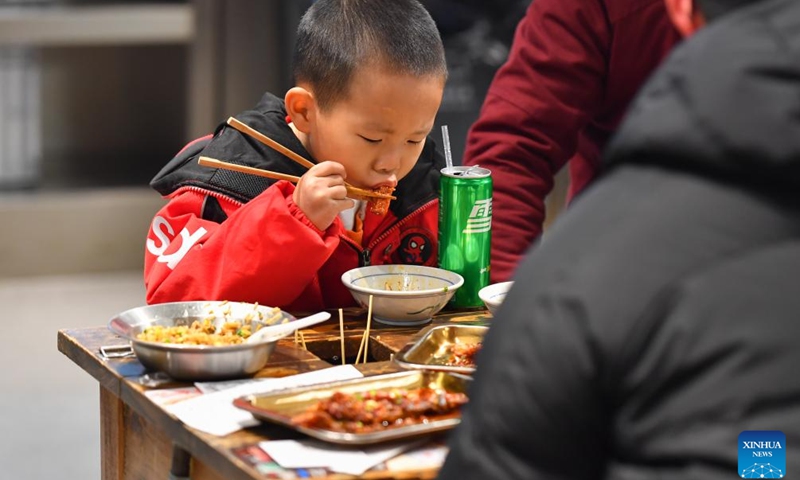Chinese delicacies gain popularity in overseas markets, with rising orders ahead of Spring Festival

A child dines at a stall in a night market selling street food in Changsha, central China's Hunan Province, Feb. 4, 2024. To attract more visitors, stalls in this night market are making innovations such as developing new products and promoting via social media.(Photo: Xinhua)
Traditional Chinese delicacies, particularly those themed with the Chinese Lunar New Year, have gained rising popularity in the global market, with some domestic producers' orders flourishing ahead of the Spring Festival holidays, which start on February 10.
From tofu to candy, these Chinese foods are catering to a wider range of people, which experts said is a reflection of how Chinese culture is gaining a foothold in the world market, particularly those countries involved in the joint construction of the China-proposed Belt and Road Initiative (BRI) amid closer ties.
At the production line of the Shanghai Dingfeng Fermentation Food Co, workers have had a busy start to the year as more overseas orders come in.
A manager surnamed Xu told the Global Times that the company's fermented bean curd or furu, a type of preserved tofu made with fresh bean curd, has become more popular these days on dining tables abroad.
During the bustling months of January and February, demand for traditional Chinese cuisine spikes, from Southeast Asia's Singapore and Malaysia to countries in North America.
BRI countries such as Pakistan and Kazakhstan are among the booming markets amid growing economic and trade ties with China and people-to-people connections, the Global Times learned from the Shanghai-based company on Tuesday.
Exports of Shanghai Dingfeng's furu, also dubbed as the oriental cheese in Chinese, have been steady at about 130 tons in recent years, generating about 1 billion yuan ($140 million) in sales and constituting roughly 10 percent of the company's total revenue, according to Xu.
Another company has seen a similar order boom. At Heshanyuan, a dumpling maker based in East China's Jiangsu Province, employees were busy packaging frozen dumplings for overseas markets, mainly Southeast Asian countries.
More and more countries are celebrating the Chinese New Year these days, particularly with the Spring Festival being officially listed as a UN floating holiday in its 2024 calendar, industry insiders said.
Against this backdrop, Heshanyuan has observed a growing appetite for Chinese dumplings abroad. Just after the three-day New Year's Day holidays, it produced more than 10,000 packages of frozen dumplings, including some for orders from European clients. It was the first time that the company had received orders from Europe.
White Rabbit Creamy Candy, a milk candy manufactured by Shanghai Guan Sheng Yuan Food Co, has a tight schedule for orders these days. From the New Year's Day holidays in late December and early January to the upcoming Chinese New Year holidays, some 250 tons of White Rabbit Creamy Candy would be exported, a year-on-year increase of about 30 percent, according to media reports.
This new momentum was based on the strong foundation last year. Throughout 2023, White Rabbit Creamy Candy was exported to 26 countries and regions with a total of 176 shipments, amounting to 1,196 tons. The main export markets included Canada, the US and the Netherlands, according to the company.
Shanghai's specialty foods such as pickled drunken crabs, fermented bean curd and dim sum are also gaining popularity overseas.
The pickled drunken crabs, for instance, made it to the overseas markets initially before the Spring Festival in 2023, and the range of exported products has expanded from one initially to seven now, according to media reports.
There is a growing trend for traditional Chinese delicacies to go global, driven by the rising consumption capacity of Chinese people living abroad as well as the growing attention and enthusiasm worldwide for Chinese culture, Zhao Jingqiao, director of the Service Economy and Catering Industry Research Center under the Chinese Academy of Social Sciences, told the Global Times on Tuesday.
Moreover, many time-honored brands are devoting more attention to foreign markets, with the domestic market being relatively saturated and competitive, the expert said.


